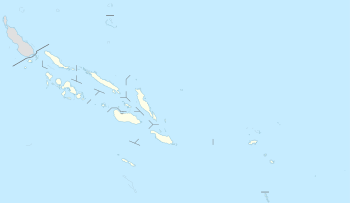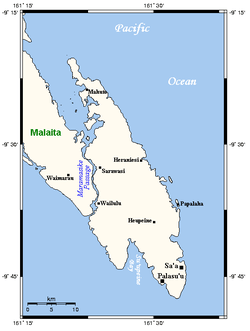South Malaita Island
The original history of Mwalamwaimwei(Small Malaita) is rooted way back from the wave of migration, as the first settlers on the land to reach on the coastal shores of Mwalamwaimwei, discover the land and its heritage. The flow of first settlers explore the land mass and settle on their respective areas within the islands. The historical facts and identity of people in Mwalamwaimwei proves by the cultural setting and practices. The prove of the first people to discover the island of Mwalamwaimwei are traditional equipped with the cultural practices, norms and historical theories. The migration goes like the recycle process such as; 1st Stage of movement:- people arrive settle on the coastal zone and move up to the highlands. 2nd Stage of movement: revolution takes place in the highlands and people move down to the coastal zone again.
| Native name: Maramasike | |
|---|---|
 South Malaita Island | |
| Geography | |
| Location | Pacific Ocean |
| Archipelago | Solomon Islands |
| Area | 480.5 km2 (185.5 sq mi) |
| Highest elevation | 518 m (1,699 ft) |
| Administration | |
Solomon Islands | |
| Demographics | |
| Population | 12,967 (2009) |
Brief Information on First settlers:
Family and Culture: The cultural setting in South Malaita, is based on the chiefly system which was inherited way back in history. The island is subdivided according to kingdom (Iola) and the division of each kingdom is done by the council of chief in the past during the pre-colonial era and later during Ma'asina Ruru Movement. High Chief: The ruling chief in South Malaita are those upper-hand people that inherit the chiefly bloodline and right to govern and rule each (Iola). The Ououinemauri is the elect high chief chosen to govern and administer the council of Chief around Small Malaita. The kingdom (Iola) exist in Mwalamwaimwei are subdivided by its boundary and territory with the chain of people who settle according to the tribes and clans across the island. Each Iola is governed by their chief( whether 2,3 or 4 chief) is setup in the kingdom based on their status in the Iola.
- These are the Iola exist in Mwalamwaimwei(South Malaita) - From: Apa iesi- To Apa ia 1. Korutalau pwaine 2. Kalapea 3. Iola Hoasiteimwane (Iola Raha) 4. Lou aatowa 5. Iola Apuilalamoa 6. Korutalaumwaimwei) 7. Iola Louatowa (Haitataemwane) 8. Iola Ueniusu (Ero ueniusu)
Other Iola in South Malaita located within and share the same boundary with each other especially the migrants or settlers who just settle and exist as small Iola.
Language: The main language spoken by the South Malaita people are categorized into 3 main dialects! - Sa'a dialect- widely spoken by 75% of the population of South Malaita. - Tolo (mix areare) dialect- is spoken by 20% of the population. - Lau dialect- is spoken by 5% of the people.

South Malaita Island, also known as Small Malaita and Maramasike for Areare speakers and Malamweimwei known to more than 80% of the islanders, is the island at the southern tip of the larger island of Malaita in the eastern part of the Solomon Islands.[1] It is called "small" to distinguish it from the much larger mainland. It is now part of Malaita Province. South Malaita came under effective control of the colonial administration after the Solomon Islands was declared a British Protectorate in 1893. The administration included the collection of taxes from the islanders.[2] During the colonial days, the island was divided by the colonial government and missionary establishments into the Asimeuri, Asimae, and Raroisu'u districts. Away from Malaita, most people from "Small" or "South" Malaita usually just say the word "South", everyone knows what they mean.
Family and cultural
People on the island, however, preferred to identify only with members of their extended families, where ties are the strongest, and with members of their clans and tribes, which are governed within traditionally demarcated regions known as iolas, which are led by a high chief ALAHAOUOU. The Island is refer to as IOLA RAHA, which consist of 8 Iola, namely Hoasitaimwane, Kolutalau, Ououmatawa, Ueniusu, Uenisu Unu, Roasi, Iolairamo and Hailadami. The language spoken by the people of Small Malaita is the Sa'a dialect. The language, however, has variations in pronunciation, grammar and vocabulary from iola to iola. The people practised patrilineal descent, with men having the most say over ownership rights and recognised as head of families, clans and tribes. Women played a much lesser role in the art of governing; however, they were equally respected in society.
Dolphin drive hunting
Dolphin are hunted in Malaita mainly for their meat and teeth, and also sometimes for live capture for dolphinariums. Dolphin drive hunting is practised by coastal communities around the world; the animals are herded together with boats and then into a bay or onto a beach. A large-scale example is the Taiji dolphin drive hunt, made famous by the Oscar-winning documentary film The Cove. The hunt on South Malaita Island is smaller in scale, and is almost exclusively practiced by the Walande and Fanelei people.[3] After capture, the meat is shared equally between households. Dolphin teeth are also used in jewelry and as currency on the island.[4]
References
- "Malaita Island". Solomon Islands Historical Encyclopaedia 1893-1978. Retrieved 22 March 2014.
- "Historical Photographs of Malaita". University of Queensland. Retrieved 20 May 2014.
- Takekawa, Daisuke (2000). Hunting method and the ecological knowledge of dolphins among the Fanalei villagers of Malaita, Solomon Islands (PDF). SPC Traditional Marine Resource Management and Knowledge Information Bulletin No. 12. p. 4.
- Takekawa Daisuke & Ethel Falu (1995, 2006), Dolphin hunting in the Solomon Islands Archived 2007-09-28 at the Wayback Machine, article retrieved on June 21, 2008.